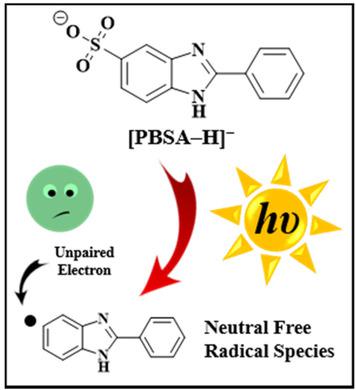当前位置:
X-MOL 学术
›
ChemPhotoChem
›
论文详情
Our official English website, www.x-mol.net, welcomes your
feedback! (Note: you will need to create a separate account there.)
Direct Observation of Photochemical Free Radical Production from the Sunscreen 2‐Phenylbenzimidazole‐5‐Sulfonic Acid via Laser‐Interfaced Mass Spectrometry
ChemPhotoChem ( IF 3.0 ) Pub Date : 2019-08-12 , DOI: 10.1002/cptc.201900149 Natalie G. K. Wong 1 , Jacob A. Berenbeim 1 , Caroline E. H. Dessent 1
ChemPhotoChem ( IF 3.0 ) Pub Date : 2019-08-12 , DOI: 10.1002/cptc.201900149 Natalie G. K. Wong 1 , Jacob A. Berenbeim 1 , Caroline E. H. Dessent 1
Affiliation

|
The common sunscreen molecule 2‐phenylbenzimidazole‐5‐sulfonic acid (PBSA) is studied in its gas‐phase deprotonated form ([PBSA‐H]−) for the first time as an important step in achieving a better understanding of its behavior as a photosensitizer. UV laser‐interfaced mass spectrometry is employed, revealing that [PBSA‐H]− photofragments into three ionic products (m/z 208, 193, and 80) with distinctive wavelength‐dependent production profiles. Both the m/z 208 and 80 channels produce associated neutral free radical species. Collision‐induced dissociation is performed on [PBSA‐H]−, showing that its hot ground‐state dissociates only into m/z 193 (statistical fragment). Therefore, the m/z 208 and 80 fragments which are produced strongly through the UVA/UVB are characterized as non‐statistical photofragments associated with non‐ergodic excited‐state decay. Our observation of non‐statistical photofragments reveal that [PBSA‐H]− is not behaving as a model sunscreen molecule. Further, our results indicate that the T1 state, associated with photosensitization, decays with direct free radical production.
中文翻译:

通过激光界面质谱直接观察防晒剂2-苯基苯并咪唑-5-磺酸的光化学自由基产生
首次以气相去质子化形式([PBSA-H] -)研究了常见的防晒分子2-苯基苯并咪唑-5-磺酸(PBSA),这是进一步了解其行为的重要步骤。光敏剂。使用了紫外激光界面质谱法,揭示了[PBSA-H] -碎屑分为三种离子产物(m / z 208、193和80),它们具有与波长相关的独特生产曲线。无论是M / Z 208个80个信道相关联的产生中性自由基物质。对[PBSA-H] -进行碰撞诱导的解离,表明其热基态仅解离为m / z 193(统计片段)。因此, 通过UVA / UVB强烈产生的m / z 208和80碎片被表征为与非遍历激发态衰变相关的非统计光碎片。我们对非统计光碎片的观察表明,[PBSA-H] -不能作为模型防晒分子使用。此外,我们的结果表明,与光敏化相关的T 1状态随着直接自由基的产生而衰减。
更新日期:2019-08-12
中文翻译:

通过激光界面质谱直接观察防晒剂2-苯基苯并咪唑-5-磺酸的光化学自由基产生
首次以气相去质子化形式([PBSA-H] -)研究了常见的防晒分子2-苯基苯并咪唑-5-磺酸(PBSA),这是进一步了解其行为的重要步骤。光敏剂。使用了紫外激光界面质谱法,揭示了[PBSA-H] -碎屑分为三种离子产物(m / z 208、193和80),它们具有与波长相关的独特生产曲线。无论是M / Z 208个80个信道相关联的产生中性自由基物质。对[PBSA-H] -进行碰撞诱导的解离,表明其热基态仅解离为m / z 193(统计片段)。因此, 通过UVA / UVB强烈产生的m / z 208和80碎片被表征为与非遍历激发态衰变相关的非统计光碎片。我们对非统计光碎片的观察表明,[PBSA-H] -不能作为模型防晒分子使用。此外,我们的结果表明,与光敏化相关的T 1状态随着直接自由基的产生而衰减。











































 京公网安备 11010802027423号
京公网安备 11010802027423号